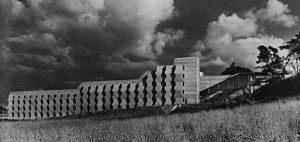Andrew Melville Hall
| Andrew Melville Hall | |
|---|---|

Andrew Melville Hall in 1964
|
|
| General information | |
| Type | Student residence |
| Architectural style | Brutalist |
| Address | North Haugh St Andrews Fife KY16 9SU |
| Town or city | St Andrews, Fife |
| Country | Scotland |
| Construction started | 1964 |
| Completed | 1967 |
| Client | University of St Andrews |
| Design and construction | |
| Architect | James Stirling |
| Website | |
| Andrew Melville Hall | |
Andrew Melville Hall is a student hall of residence of the University of St Andrews located in St Andrews, Fife, Scotland. It was built in 1967 in the brutalist style, and it accommodates approximately 275 students.
Designed in the New Brutalist style by the renowned architect James Stirling, Andrew Melville Hall was built during a major expansion of the University in the 1960s using prefabricated concrete modules. Errors in construction meant that extensive remedial work was required over several decades. Plans for further buildings to the same design were abandoned.
It was named after Andrew Melville, a 16th-century Scottish scholar, theologian and religious reformer who was a graduate of the University, and who later became its rector and dean of theology.
It is of a striking design and is situated prominently at the North Haugh on a ridge overlooking the St Andrews Links. The hall resembles passing ships, a common theme of the architect's style.
It has become an important architectural landmark: It was included in DoCoMoMo's 1993 list of Key Scottish Monuments and was ranked number 12 in the top 100 Scottish buildings of the last 50 years. The building was listed Category A in 2011.
Alex Salmond, a former First Minister of Scotland, stated that he had lived at Andrew Melville Hall when a student at St Andrews.
During the academic year students live in Melville, with the vast majority of these in single rooms. Every room looks out over surrounding parkland, inhabited by a large number of wild rabbits. The hall is divided into five blocks, designated A, B, C, D and E. Generally A, C and E blocks are mixed, with B block being all male and D block all female although in recent years A block has been all male in addition to B block.
...
Wikipedia
